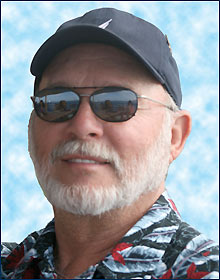Prostate Cancer Treatment with Calypso Technology

George Padgett
During a routine medical exam, my primary care physician suggested we conduct a PSA test. The results of the test indicated that my PSA score was 7.0, definitely higher than the normal range of 1.0 - 4.0. A subsequent biopsy was performed, and the results indicated the presence of cancer. To learn I had cancer was overwhelming. To get through this process, I relied on my faith, my superb support group, and the knowledge that there was excellent technology available to feel confident that I would be fine.
I discussed the results of the biopsy with physicians from two different urology practices, and both felt that the best course of treatment would be a radical prostatectomy (removal of my prostate). I did a series of Internet searches to be more informed about prostate cancer and its treatment. One of the resources I found on the UMMC Web site was a video of talking about the latest advances in prostate cancer surgery.
I chose the robotic prostatectomy method because it provides minimal damage to the abdominal area and provides for a shorter recovery time. I had surgery on a Friday and left the hospital on the following Sunday.. After surgery, my PSA score was reduced from 7.0 to 0.1. I was able to play a round of golf within five weeks and began my normal circuit training routine within six weeks. Following surgery, there were periods of incontinence lasting approximately eight weeks.
The pathology report demonstrated that all the cancer was removed with a negative margin, but the tumor was aggressive and had started to grow beyond the prostate, therefore, my surgeon recommended a course of radiation to kill any remaining microscopic disease.
Prior to the radiation treatment, my surgeon implanted three tiny transponders into my prostate area. The transponders -- part of a new technology called Calypso -- emit radiofrequency waves which are used to very accurately align the prostate area and minimize the risk of destroying neighboring tissues during treatment. I thought this process was a great idea.
The procedure to implant the transponders was conducted in the doctors office and only took about ten minutes. I had no pain and was able to drive home and continue with my daily activities. The Greenebaum Cancer Center is one of the first centers in the region to use the Calypso technology, known as "GPS for the body." I was the first patient at UMGCC to be implanted with these transponders.
Side effects during the radiation treatment were very minimal. I was able to continue power walking, circuit training and playing golf. The therapists at the Radiation Oncology department are very compassionate and empathetic. They explained the radiation process in detail, which made me feel at ease.
I highly recommend Dr. Amin as an expert source of information and treatment for prostate cancer. I was very comfortable in discussing my cancer and the treatment options with him. He is very friendly, highly experienced and extremely knowledgeable.
Today, I feel great and plan on having a long and happy life. My advice to others is to do your research, talk with your family, and ask lots of questions of your doctors. The more informed you are, the better prepared you will be to make decisions about your treatment. Be brave, take charge of your situation, and be your own advocate.


